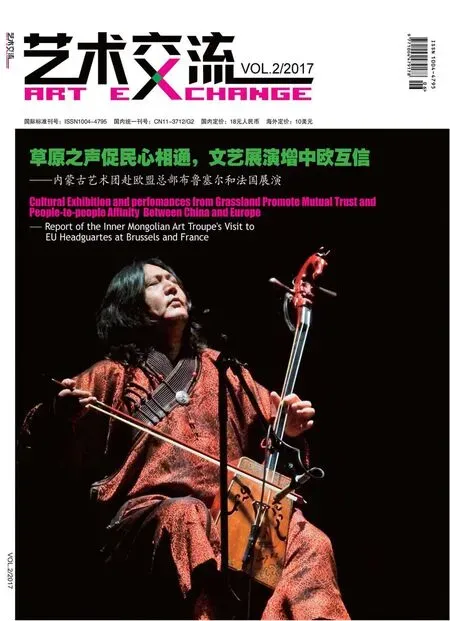《白毛女》是任何时代都令人难忘的故事
——松山芭蕾舞团点滴故事
文本报记者 张亚萌Zhang Yameng 译曹宇光Cao Yuguang
《白毛女》是任何时代都令人难忘的故事
——松山芭蕾舞团点滴故事
Unforgettable Story of White-haired Girl at any Time——Legend of Matsuyama Ballet
文本报记者 张亚萌Zhang Yameng 译曹宇光Cao Yuguang
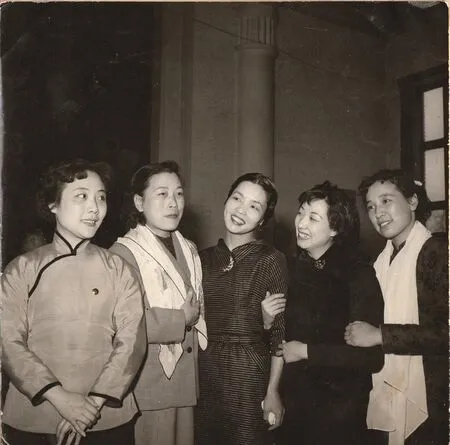
1958年王昆(左二)与松山树子(中)等合影Group Photo of Wang Kun (second at the left) and Mikiko Matsuyama (center) in 1958
中美之间的“兵乓外交”广为人知,中国与日本之间,更有“芭蕾外交”的故事——1958年,日本松山芭蕾舞团舞剧《白毛女》首次登上中国舞台,近半个世纪的岁月中,松山芭蕾舞团曾先后14次来华访问演出,写下了中日民间交流不朽的传奇。为纪念中日邦交正常化45周年,5月16日至24日,松山芭蕾舞团来华演出大型新编芭蕾舞剧《白毛女》,开启其第15次访华之旅,再续艺术、友谊、和平的佳话。
本次访华演出由中国国际文化交流中心、中国文联、上海市对外文化交流协会主办,于5月19日晚在北京人民大会堂首演。选择这一演出地点颇有纪念意义——1964年9月,松山芭蕾舞团第二次访华时曾在人民大会堂小礼堂演出,当时,毛泽东、周恩来、朱德等中国国家领导人观看演出并接见了全体演员。
“《白毛女》是任何时代都令人难忘的故事。通过《白毛女》,我们和中国紧密地连接在一起了。”松山芭蕾舞团创始人、前任团长清水正夫曾这样说,“我相信,无论中国的现代化今后取得多么大的成就,即使中国的科学技术和经济文化成为世界第一了,《白毛女》也仍是一部必须经常反复回忆的民间故事”——从上世纪50年代民间交流破冰,到中日邦交正常化的 70年代,直至21世纪的今天,都如清水正夫所言,“《白毛女》是中日友好的基石”。
从第一次访华那天起,中国就成了我“心中的故乡”
1945年,王昆主演的歌剧《白毛女》首演于延安;1950年,田华主演的电影《白毛女》在长春摄制完成,并于1952年在日本首次放映。当年秋天,清水正夫和松山树子夫妇看到电影,深受感动,便萌生了将“白毛女”这个故事改变成芭蕾舞的想法,“当时才18岁的田华女士在《白毛女》中扮演的喜儿,又可爱又坚强,引起了我们强烈的共鸣。自那以后,我们就像着了迷似的投入到编导芭蕾舞《白毛女》的工作中。”清水正夫在《松山芭蕾舞“白毛女”——日中友好之桥》这本书中这样回忆。为了创作,清水家变卖了房产,筹资借钱,还要顶住日本右翼和反华势力的压力,经过两年多的艰苦创作,1955年2月12日,继歌剧、电影之后,芭蕾舞剧版的《白毛女》在东京日比谷会堂公演,导演是土方与志,服装是土方梅子,制作是清水正夫,主演是松山树子。
“我还很清楚地记得芭蕾舞《白毛女》的首演,我亲自感受到观众的热情,我只是拼命地跳舞。谢幕的时候,观众的掌声经久不停。我看到前排的观众都流着泪水,有的甚至大声地哭了起来,台上的演员也抑制不住自己的感情,都流着眼泪谢幕”,松山树子回忆。
通过当年的赫尔辛基世界和平大会,清水正夫见到了中国代表团团长郭沫若,他很愉快地满足了日本代表团“希望访问中国”的愿望——1955年国庆节的宴会在北京饭店大厅举行——那时人民大会堂还没有建成,据受邀的松山树子回忆,周恩来总理和许多中国国家领导人都到了,宴会很气派;在宴会的高潮,周总理突然对外国记者团说:
“现在宣布一件重要事情。”
大家都以为有什么事,气氛有点紧张。周总理领着两位漂亮的中国妇女走到松山树子面前,向她伸出手:“朋友们,这里有三位‘白毛女’。”——王昆、田华、松山树子,三个“白毛女”紧紧握了手,留下了珍贵的照片。
“白毛女回娘家来了。”在宴会上,周总理对松山树子说:“下次带着《白毛女》,大家一起来。”
“我把周总理的这句话像宝贝一样记在心里踏上了归途;这一次在北京的场面是我终生难忘的。”松山树子回忆,当时中国正开始提倡“百花齐放、百家争鸣”,周总理就这样亲自为文艺的发展而努力工作着,“松山芭蕾舞团所受周总理的照顾,真是说也说不尽的”。
酷爱舞蹈的松山树子,素来不爱留恋过去,但战争给她留下了不灭的印象,她开始认识到不该忘记战争、不该忘记过去。“从第一次访华那天起,中国就成了我‘心中的故乡’。”松山树子曾这样说。
“1958年,我们实现了首次访华公演的愿望。这是中国和松山芭蕾舞团的初次交往,当时年轻的新中国正在朝气蓬勃地进行着国家建设,松山芭蕾舞团也是刚刚开始起步。”清水正夫这样记录。1958年3月3日到5月1日,松山芭蕾舞团一行46人应周总理的邀请进行为期两个月的第一次访华演出。演出共28场,代表团先后在北京的天桥剧场、重庆的人民礼堂、武汉的中南剧场、上海的人民文化广场等地公演《白毛女》《胡桃夹子》等剧目。
从日本来的芭蕾舞团表演中国革命故事,而且演员们和中国人长得一模一样,中国观众和日本观众一样理解芭蕾舞。戏票从前一天晚上开始公开出售,通宵排队买票的人连成一片。据松山树子回忆,他们只从中国方面得到过一次“规劝”:当时的中国,只有丧事时才穿白鞋,于是舞团马上把男演员的白舞鞋涂成黑色。
当时,北京天桥剧场正在上演王昆主演的歌剧《白毛女》,王昆为了松山芭蕾舞团的演出搬到附近的另一个剧场继续“唱”《白毛女》;“梅兰芳先生所在的中国京剧团,在我们演出后不久创作了京剧《白毛女》,公私合营的京剧团也开始演出《白毛女》——歌剧、芭蕾舞、京剧都开始演《白毛女》,北京顿时形成了白毛女的比赛会,一个前所未有的‘白毛女热’出现了。”
芭蕾版《白毛女》自然最受关注,“我看过很多芭蕾舞,但是还没有看到过像《白毛女》那样使我感动的芭蕾舞。这是由于这部芭蕾舞和劳动人民的生活与斗争联系在一起了。”著名戏剧家欧阳山尊这样写道。以《人民日报》为首的多家报纸登载了《白毛女》的报道,那时候,报纸每天都用巨大版面刊登张乐平、郁风画的速写,诗人为《白毛女》写的诗,松山芭蕾舞团来华公演成了重要新闻,传遍整个中国。
真想大喊一声“万岁”
1972年9月29日,中国政府与日本政府发表联合声明,建立中日外交关系,至此,日本长达约半个世纪的“与中国隔绝”宣告结束。“通过卫星传送,我们看到了北京的情况,大家如释重负,真想大喊一声‘万岁’。但是,由于日中断绝关系如此之长,当时的心情不属于那种欢聚一堂乱蹦乱跳的欢乐,而只是在自己的内心深深地感到的一种喜悦。”清水正夫说。其实,在中日邦交正常化之前,松山芭蕾舞团就已经完成了第三次访华演出,1971年第三次公演,森下洋子和清水夫妇之子哲太郎已经挑起了大梁;周恩来总理亲自观看演出,上台与主要演员森下洋子亲切握手并接见全体演员;1972年7月,上海舞剧团访问日本,史学家戏称为中日建交历史进程中的“芭蕾外交”。
“在天桥剧场演出那一晚,周总理去后台看大家,见到我就问:你是正夫的儿子吗?”松山芭蕾舞团现任总代表清水哲太郎回忆;现任理事长、舞蹈家森下洋子更是常说“昔日之恩,无以为报”:当时周总理特别忙,但再忙也会挤时间看松山的演出;那次演出后,周总理送给她一件演出服;作为当今世界芭蕾舞台上最高龄的舞蹈家,今年已经69岁高龄的她决定穿着1971年周总理送的这件演出服,完成全场《白毛女》的演绎。
“1975年,我19岁,随中国北京艺术团出访日本。当时接待并全程陪同我们的是清水正夫先生。记得在欢迎晚宴上,他首先讲了三句话:我是最爱中国的日本人,我也是最爱中国文化的日本人,我更是向中国人民谢罪的日本人。”中国国际文化交流中心理事、舞者尹建平今天回忆起当时的“震撼”,仍感动不已。
“记得我在大阪期间,突发急性胃炎,清水先生就站在下场口,手拿着胃药、端着水,等我下场,这一场景至今历历在目。”在京都演出的时候,日本右翼扬言要在演出期间闹事,“清水正夫先生请来几十个京都少林寺的青年为我们的演出保驾护航,他站在台侧对大家说:请大家放心,有我们在,你们什么都不用担心!”尹建平说。这并非孤例,1972年上海舞剧团访日时,右翼分子扬言扔燃烧弹,清水先生让哲太郎和洋子夫妇化妆成剧中人物,穿着《白毛女》的演出服等在后台,提着浸过水的毛毯,防止右翼和黑道的破坏。
1978年9月,松山芭蕾舞团又一次访华,“在北京机场我看到了来迎接我们的中国朋友,在这一瞬间,我突然感到有一种在文化大革命的时候所没有过的舒畅气氛。中国朋友们都像刚飞出笼的小鸟一般,自由地交谈和无拘束地表达自己的感情,从他们的这种表情和语言,以及一举一动中,我们看到了一个新的时代。”清水正夫和松山树子,是中国社会发展变化的见证者。“大家用‘热烈欢迎’这样的语言来欢迎我们,鼓掌和欢使团员们的两颊绯红。每当我们受到中国朋友们这般欢迎时,便有一种终于回到了自己家一般的安然心情。这是因为我们对于中国朋友们的迷恋,已经到了难以想象的地步。”清水正夫曾这样说。
“我们是东京的延安”
“我们应当认识到,环境、周围的人以及自己本人都在随着时代的潮流而变化,而且应当知道哪里是转折点。但是,有一件在任何时候都不允许发生变化的东西,那就是一颗善良的、信任人的心。”松山树子曾如此表示,“看看现在的社会,人们都在忙忙碌碌。社会越是现代化,人们就越像被机械所驱使着一样。在激烈的合理化和机械化中,人正在失去人所固有的天性,这个天性,正在日益不为人们所重视。我们所从事的芭蕾舞这门艺术可以比喻为手工业,这和机械化的社会之间恐怕差别太大了。为此,我有时会突然感到一阵恐怖。芭蕾舞是严格地锻炼出来的一种艺术,是用人的灵魂创造的艺术。正因为如此,我更感到,在这样一个时代,我们所从事的工作是宝贵的,是有价值的。”
清水正夫已经远去,松山树子已近百岁高龄,而他们自1948年建团就定下的“上演古典芭蕾”和“创作具有民族特色的芭蕾舞”的宗旨,以及对芭蕾和中国的“初心”,还在松山芭蕾舞团代代相传。每当日本松山芭蕾舞团来华访问演出时,他们都主动前往抗日战争纪念馆、延安等中国抗日圣地,并代表日本忏悔谢罪,与当地的人民交流联欢。只要走进松山芭蕾舞团的练功厅,映入眼帘的,首先是挂在墙上的毛泽东、周恩来、邓颖超的照片,以及用中日两种文字书写的励志标语:“团结、紧张、严肃、活泼”“一不怕苦、二不怕死”。
“我们是东京的延安。”松山芭蕾舞团的所有团员,都会这样“标榜”自己。
1964年,上海芭蕾舞学校首次演出了《白毛女》,上海成为芭蕾版《白毛女》的诞生地;今次,5月23日晚,新版《白毛女》亮相上海大剧院。中日两国几代芭蕾“白毛女”再次重逢。5月20日,松山还赶赴周恩来的故乡江苏淮安,从某种意义上说,松山芭蕾舞团拜谒周总理的故乡,也是一次感恩之旅。
“舞团加紧排练《白毛女》时,他们在东京郊区做了一个专门的排练剧场,进行了3天的全本演出式排练;同时他们在排《罗密欧与朱丽叶》,但全体团员每天挤出几小时自己练。”松山芭蕾舞团评议员、舞者郑一鸣介绍,很多道具都是团员自己做的,装台卸台都是全体团员和工作人员一起装卸,“演出时,在边边角角的演员,状态都是特别饱满的,向心力特别强,世界上这种芭蕾舞团不太多了。”
“日本人演《白毛女》意义深刻,我们研究农民,研究八路军的历史,把这些历史传达给演员,通过艺术表现我们的诚意:中日人民应当和平友好地携手前行。”清水哲太郎说。“喜儿这个角色教会我面对困境时要坚强”,森下洋子说。谈及新版之“新”,清水哲太郎直言故事没有改编,而是增强了群体形象,突出大量群体“喜儿”的场面,使之更有震撼力。“这一版的‘新’,就在于保持了中国舞者以前有而现在没有的状态。”尹建平说。
“我们希望展现向往美好与和平之心,希望中日两国的朋友一起幸福地生活,通过芭蕾艺术,建立两国友好,是几十年来我们一直坚持的心。”森下洋子说,《白毛女》这个“伟大的作品值得所有人欣赏”。
半个多世纪以来,无论中日关系冰雪摧残还是柳暗花明,松山芭蕾舞团都始终不渝地在为中日世代友好做着自己的努力,每当中日关系出现裂痕时,他们总是第一个站出来维护和支持中日民间友好的大局。1985年,清水正夫曾说:“我们在日本和中国之间所走过的这1/4世纪,在宏大的世界河流中,也许只是瞬间流过的涓涓一滴,我们所做的工作,也许是微不足道的。但是,曾被封锁了的日本和中国现在正在手拉手地准备开创一个新的时代。认为历史变了、社会变了的人,大概不只我一个。也许我们当时恰好是走到了那个时代的转折点上吧,然而,现在,我们所有的人类恐怕都正处在世界的转折点上。不管世道和时代今后出现什么变化,我们热爱中国的心情是不变的,而且,我相信,对中国朋友的友情一定能代代相传下去。”
点滴成河,岁月可鉴。
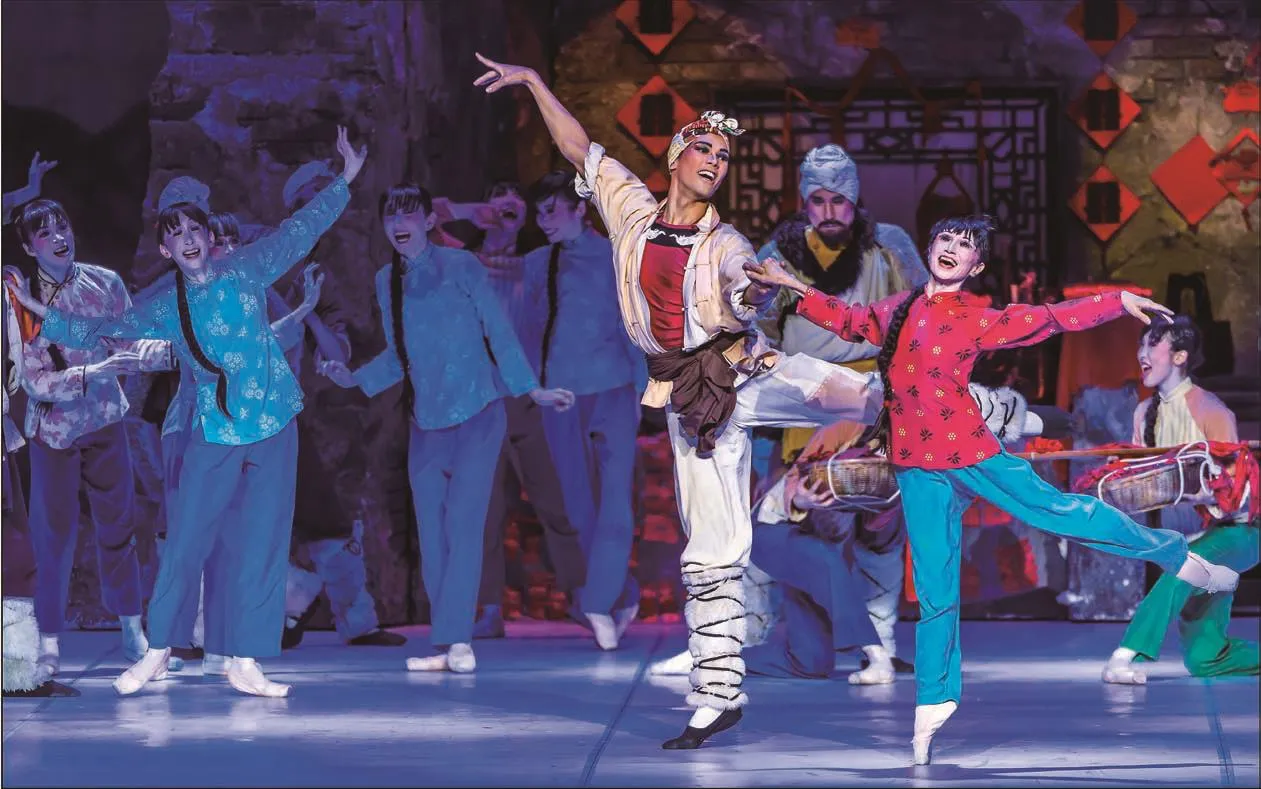
松山芭蕾舞团新编芭蕾舞剧《白毛女》演出现场Performance of the Revised Ballet Drama White-haired Girl in China
Similar to the “tabel tennis Diplomacy” between China and USA, there exists a “Ballet Diplomacy” between China and Japan. Ever since the year 1958 when Matsuyama Ballet Company of Japan premiered their White-haired Girl on the China’s stage, this company has visited China to stage performances on 14 occasions and composed a lasting legend of people to-people exchange between the two countries. In commemoration of the 45th anniversary of Normalization of Diplomatic Relations between China and Japan, from May 16 till 24, Matsuyama Ballet Came to China to stage the revised ballet drama White-haired Girl as their 15th journey and extended this legend of art, peace and friendship.
This special performance was jointly sponsored by China International Cultural Exchange Center (CICEC), CFLAC and Shanghai International Culture Association, The premier was set on the evening of May 19 at the Great Hall of the People in Beijing, which carried so much memorable indication. In September of 1964, Matsuyama Ballet staged their performance in the small auditorium at the Great Hall of the People in their second visit to China and the national leaders of China then sach as Mao Zedong, Zhou Enlai and Zhu De watched the performance and met with the entire company after the performance.
“The White-haired Girl is always an unforgettable story at any period of time. It has connected us closely to China.” Masao Shimizu, the founder and the ex-president of Matsuyama Ballet once said, “No matter what great achievement will be made in China’s modernization and even if China becomes world-leading in scientific technology, economy and culture, the White-haired Girl is still a folk story we need to recall from time totime”. From the ice-breaking in people-to-people exchange in the 1950s to the normalization of diplomatic relations in the 1970s and till the current period in the 21st century, as Masao Shimizu said, this play still functions as the basis of China-Japan friendship.
China my Became Hometown at Heart on my First Day of Visit
In 1945, the opera White-haired Girl featured Wang Kun was premiered in Yan’an, in 1950, the samename film featured Tian Hua was completed in Changchun and shown in Japan for the first time in 1952. When the couple Masao Shimizu and Kiko Matsuyama saw this film in that autumn, they were so touched with the plot that they were determined to choreograph this story into ballet. “The actress Ms. Tian Hua was no more than 18 years old, and Xi’er, the heroine of the film, was adorable and perseverant, which aroused great sympathy among us. From then on, we were totally fascinated with the choreography of the ballet White-haired Girl.” Masao Shimizu recalled in his book White-haired Girl by Matsuyama Ballet—China-Japan Friendship Bridge. For the sake of creation of theballet, the Shimizus sold their house and went on leans After more than two years’ artistic creation against the pressure of Japan’s right-wing and anti-China forces, on February 12, 1955, the ballet version of Whitehaired Girl, following the opera and film versions, was premiered at Tokyo Metropolitan Hibiya Public Hall, with Yoshi Hijikata as director, Umeko Hijikata as costume designer, Masao Shimizu as producer and Kiko Matsuyama as heroine.
“I can still recall clearly my premier in the ballet White-haired Girl in China. As I deeply felt the Chinese audiences’ passion, I tried my best uhile dancing on the stage. In our response to a curtain call, their applauses lasted quite a long time. I saw that those in the front rows were already in tears and some even cried out.At this, we couldn’t help shedding tears as we bid goodbye to Chinese audiences.” Kiko Matsuyama said.
On the occasion of World Peace Conference in Helsinki, Masao Shimizu managed to meet with Guo Moruo, head of China’s delegation, who, in a pleasant mood, agreed to help the Japanese counterpart’s wish to visit China come true. In 1955, the banquet for National Founding celebration took place in Beijing Hotel, The Great Hall of the People was still under construction then. As Kiko Matsuyama recalled, Premier Zhou Enlai and many national leaders from countries attended this grand banquet.At the climax of Premier Zhou Enlai unexpectedly called to the foreign correspondents.
“I would like to make an important announcement.”
As people assumed for something terrible, the atmosphere was a bit tense. Premier Zhou took two beautiful Chinese ladies to Kiko Matsuyama and stretched out his hand. “Friends, we have three White-haired Girls now.” Those three “White-haired Girls”held each other’s hands, which became a precious instant in the photo.
“Our White-haired Girl has returned home,” Premier Zhou said to Kiko Matsuyama at the banquet, “If you can bring your ballet version to China, all of us will definitely be your audiences.”
“This word of Premier Zhou stayed in my heart like treasure on my way back to Japan and what I experienced in Beijing has become my lasting memory.” Kiko Matsuyama recalled. At that time, China advocated the principle of “Let Hundred Flowers Bloom and Let Hundred Schools Contend”, and Premier Zhou worked vevy hard at promoting the literary and art development.“The auspice from Premier Zhou for our ballet company is far beyond words”.
As a devoted dancer, Kiko Matsuyama hardly lingers about the past. However, as the war made ine ffaceable impressions onher mind, she realized that any war in the past should never be forgotten. “From the first day of my visit, China has become a hometown in my heart.” Kiko Matsuyama said.
“In 1958, our wish to premier our ballet in China finally came true, which became the first encounter of Matsuyama Ballet with China. At that time, the New China still in its vevy youth was undertaking national construction with full vitality And our ballet company was quite young as well.” Masao Shimizu wrote in his book. At the invitation of Premier Zhou Enlai, from March 3 till May 1, a 46-member Matsuyama Ballet came on their virgin tour in China. During almost two months, Matsuyama Ballet staged such programs as White-haired Girl and the Nutcracker respectively at Tianqiao Theatre in Beijing, the People’s Auditorium in Chongqing, Zhongnan Theatre in Wuhan and the People’s Cultural Square in Shanghai.
People were curious to see how a Japanese ballet company stage a Chinese revolutionary story,though their actors and actresses look like Chinese. A long queue was formed overnight as the tickets were scheduled to sell on the previous evening. As far as Kiko Matsuyama remembered, the company only got one suggestion from Chinese side. As the Chinese people then only wear white shoes on the occasion of funeral and actresses', the company immediately order to have all the actors’ white shoes painted in to black.
At the same time, the opera White-haired Girl featured Wang Kun was about to take place at Tianqiao Theatre, but for the sake of Matsuyama Ballet, Wang Kun moved to a nearby theatre. “The China Peking Opera Ensemble headed by Master Mei Lanfang created Peking opera version of White-haired Girl soon after our performance and all the Peking opera troupes started to stage this play from time totime. With various art forms of a single story, Beijing then became a competition arena for White-haired Girl and an unprecedented fashion of ‘White-haired Girl’ came into being immediately.”
Of course, the ballet version was most eye-catching. “Among so many ballet productions I have seen, there is no such ballet as White-haired Girl that touched me so greatly, because, I suppose,this ballet makes a connection with the laboring people’s struggle and life.” Ouyang Shanzun, a prestigious Chinese theatre expert once commented. Many media including the People’s Daily provided such interesting reportage of this ballet in great space of page as the sketches made by Zhang Leping and Yu Feeng,and poetry in praise of this ballet. As an important piece of news, Matsuyama Ballet’s visit and performance in China became well-known throughout China.
Hearty Cheers for Normalization of China-Japan Diplomatic Relations
On September 29, 1972, a joint communiqué between Chinese government and Japanese government was issued and the diplomatic relation was then established, which symbolized that Japan’s “isolation from China” in almost half a century came to an end. “Via satellite transmission, we witnessed that great moment in Beijing and felt relieved. We truly wanted to cry out our hearty cheers, but as the separation between the two countries was quite a long time, we only enjoyed an inner joy and peace in mind instead of gala for reunion.” Masao Shimizu said. As a matter of fact, Matsuyama Ballet had accomplished its third visit performance in China before the normalization. In 1971, the actress Yoko Morishita, along with Tetsutaro Shimizu,son of Shimizu couple, became the backbone cast, Premier Zhou Enlai came to watch the performance, shook hands with Yoko and met all the artists after performance. In July 1972, Shanghai Dance Drama delegation visited Japan, Completing what was called by historians as “Ballet Diplomacy” during the course of China-Japan relations establishment.
“On the evening of our performance at Tianqiao Theatre,Premier Zhou Enlai came to visit us at the backstage. as soon as he met me he asked me,‘are you the son of Mr. Masao Shimizu?’” Tetsutaro Shimizu, the current chief representative of Matsuyama Ballet recalled. Yoko Morishita, the famous dancer and president of Matsuyama Ballet, concluded it as “Amazing grace beyond repayment”. Premier Zhou Enlai was extremely busy with his work, but he would spare no time to watcr the performance by Matsuyama Ballet. Premier Zhou Enlai preseuted a set of costume to her As a agitt. As the oldest dancer on the current world ballet stage, this 69-year-old dancer is decided to present a full-length performance of White-haired Girl in the precious costume gifted by Premier Zhou Enlai in 1971.
“In 1975, I came with Beijing Art Troupe to Japan at the age of merely 19. It was Mr. Masao Shizimu who received us and accompanied us in the whole trip. I still remember three sentences of his at the welcome dinner. ‘I’m a Japanese who loves China most, who loves Chinese culture most and who wants to apologize for our past offence.’” When recalling those shocking words, Yin Jianping, dancer and council director of CICEC, was still emotionally touched.
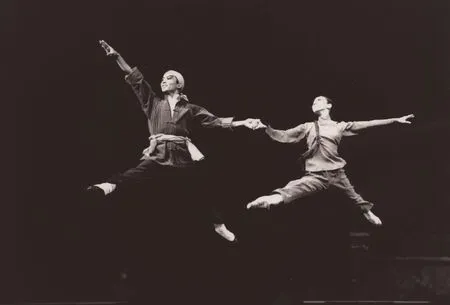
清水哲太郎、森下洋子在演出中Tetsutaro shimilu and Yoko Morishita in Performance
“During my performance in Osaka, acute gastritis happened to me unexpectedly. Mr. Shimizu while they were held pills and a glass of water in his hands, waiting at the stage exit, which still occurs to my mind.”while they were in Kyoto, some Japanese right-wing forces threatened to make trouble. “Mr. Masao Shimizu invited scores of youngsters from Shaolin Temple at Kyoto as our bodyguards He said to us, ‘Please feel reassured.With our presence, you have nothing to worry about!” Yin Jianping quoted. It was actually not a single case. During Shanghai Dance Drama delegation's visited Japan in 1972, some right-wing forces threatened to throw incendiary bombs. Then Mr, Masao Shimizu told his son and daughter-in-law to wear costumes of White-haired Girl and wait at the backstage while holding the soaked carpets against of any sabotage attacks from right-wing or govngster forces.
In September 1978, Matsuyama Ballet visited China once again.“The instant I met our Chinese friends at the airport, I suddenly fett a carefree atmosphere that was never available in the‘Cultural Revolution’. Like birds freed from cage, Chinese friends talked with us and expressed their emotions in an unrestricted way. From their countenance, language and style, we saw a brand new age.” Masao Shimizu and Kiko Matsuyama have become witnesses of China’s social development and evolution.“When Chinese friends said ‘warm welcome’ to welcome us, our artists’ cheeks twrned into in rose color. Every time we received such a warm welcome by Chinese friends, we felt at ease, as if we wereat home. again Probably our fascination with Chinese friends has developed far beyond imagination.” Masao Shimizu once said.
We are Revolutionaries at Tokyo
“We are fully aware that period, environment and people surrounding us and even ourselves are changing along with the time and fashion with a clear sense of where the turning points.are However, there is something that cannot allow any change, and it is a heart of good will and trust.” Kiko Matsuyama once expressed, “People nowadays are so busy. The more modernized the society appears, the busier people will be strictly driven as if by machines. In the severe course of rationality and mechanization, people are losing their human nature which receives less and less attention. The ballet art ehat we are engaged to can be compared to handicraft that have a sharp difference from this mechanical society. For this reason, I feel a kind of horror from time to time. Ballet is an art that comes from severe training and spiritual creation. In this sense, I feel more confident that in this age our job is of great value”.
Though Masao Shimizu has passed away and Kiko Matsuyama is already in her 90s, their artistic mission to “stage classicalballet” and “create ballet of distinct national feature”set for this company since its founding in 1948, as well as their initial affection for China and ballet, still pass on from generation to generation. Whenever this company visits China, they will invariably visit Anti-Japanese War Memorial Museums and revolutionary headquarters such as Yan’an to apologize for Japanese invaders’ crimes and hold gala performance with local people. Upon entering the rehearsal hall of Matsuyama Ballet, one will finds the photos of Chairman Mao, Premier Zhou Enlai and Madame Deng Yingchao as well as encouraging mottos written in both Chinese and Japanese such as “Unity,seriousness, Earnesty, Vitality” and “Fear neither Hardship nor Death”.
“We are revolutionaries at Tokyo.” All the artists in Matsuyama Ballet make such a proud self-introduction.
On the evening of May 23, the new version of White-haired Girl premiered at Shanghai Grand Theatre. In 1964 Shanghai Ballet School first Presented Chinese ballet version of White-haired Girl in Shanghaiin InShanghai, those “White-haired Girls” of all generations from both China and Japan got reunited. On May 20,the company visited Huai’an in Jiangsu Province, the hometown of Premier Zhou Enlai. In a sense, such homage by Matsuyama Ballet was also a journey of gratitude.
“Currently, the company is busy with rehearsal, It has spent five or six million Japanese yen in establishing a theatre in the suburb of Tokyo for full-length rehearsal of three days. Though they are preparing another play Romeo and Juliet, every artist of this company still squeeze out some hours for rehearsal by themselves.” Zheng Yiming, dancer and critic of Matsuyama Ballet introduced that some props are made by artists themselves and all dancers join the stage setup and dismantlement. “During the performance, even those walking roles are totally devoted with high spirits, which is hardly seen in other ballet companies in the world”.
“There is great significance in our Japanese play of White-haired Girl. We have Conducted studies on Chinese farmers and Eighth Route Army’s history, and conveyed such historic discoveries to our artists. By owr performing art, we would like to present our sincere expectation that the peoples of China and Japan stride for ward hand in hand.” Tetsutaro Shizimu said.
“The role of Xi’er has taught me to be perseverant in confrontation of difficulty.” Yoko Morishita admitted. As to the“New” feature in the latest version, Tetsutaro explained that thouyh the plot was not adapted,Producing a effect the group image of Xi'er was greatly enhanced with a scene of muttiple Xi'er together of shocking influence. “The ‘new’ core of this version lies in their unusual artistic disposition that Chinese dancers used to enjoy but no longer boast Nowadays.” Yin Jianping said.
“We hope to demonstrate our expectation for beautiful life,world peace and happy life that friends of China and Japan together. It is our persistent wish for decades that ballet art can build up friendship between owr two countries.” As Yoko Morishita put, “This a great works of White-haired Girls deserves to be appreciatedly all the people”.
For half a century, no matter in great difficulty or in promising transition in the China-Japan relationship, Matsuyama Ballet has been making their perseverant efforts for the everlasting friendship. Every time when crisis occurs, they will invariably the first ones to safeguard and support the friendship between the two peoples. Masao Shimizu once said in 1985, “The quarter of century with the grand stream of the world, we might be just a tiny drop or an instant. What we have done so far might be too trivial to mention. Nevertheless, Japan and China, once blocked from each ofher, are ready to open up a new age in joint efforts.Many people, including me, have realized the change of history and society, Probably we are located at the turning point of our tines or even for the entire world. No matter what change mag take place inthe fature, our love of China will remain, And I firmly believe that our affection with Chinese friends will passon from generation to generation.”
Indeed, it is for many tiny drops that Ththas been proren a flowing stream of friendship can sustain, Thathas been proren and remembered througout history.
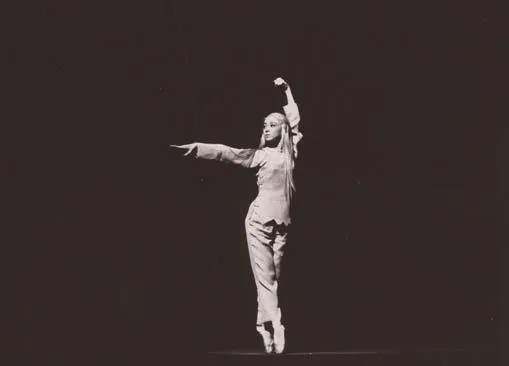
青年时期的森下洋子演出《白毛女》Yoko Morishita in her Youth Performing in White-haired Girl
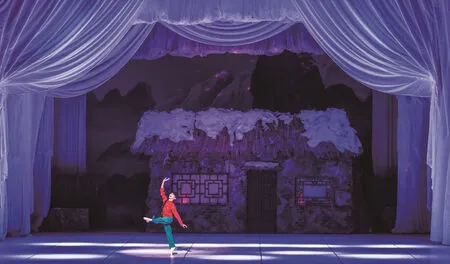
松山芭蕾舞团新编芭蕾舞剧《白毛女》演出现场Performance of the Revised Ballet Drama White-haired Girl in China

